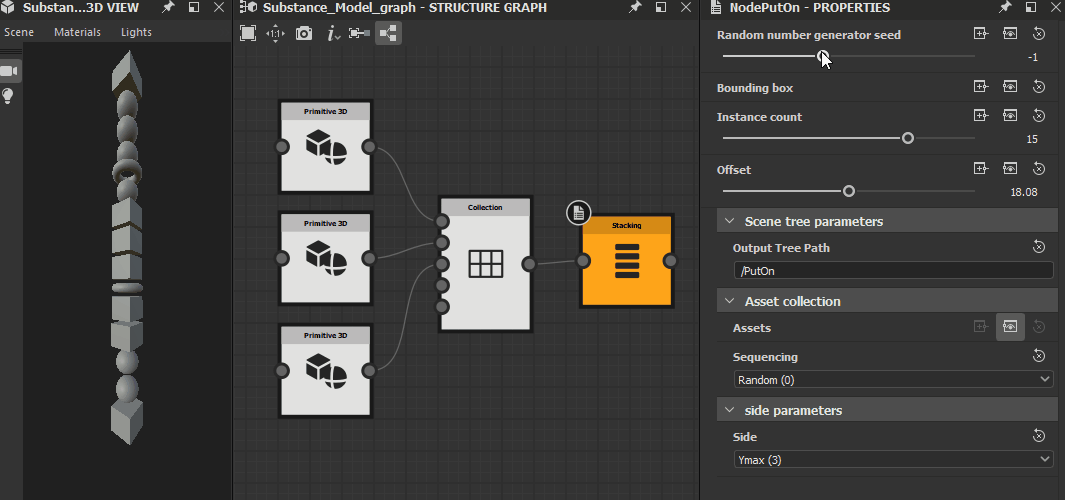Last updated on
Jul 13, 2023
Stacking


In: Substance Model graph/Distribution
Intermediate
Description
The Stacking node stacks instances of input elements along a specified axis. Stacking means the instances are places next to or on top of each other, using their bounding box to determine the offset from one instance to the next.
The location where the stack should start can be defined using an input scene's bounding box. For instance, a stack can 'rest' on top of an input Cube primitive.
Parameters
- Scene parameters
- Output scene path String
Sets the item name and possibly its containing groups. Learn more in the Path expressions and filtering section.
- Output scene path String
- Random number generator seed Integer
Random seed value used in the pseudo-random distribution of elements from the input collection. - Asset collection
- Assets Scene
Scene containing elements which should be used as a collection to pick from for generating instances. All elements directly under the root of the Scene are included in this collection. - Sequencing Integer (selects an Enum index)
Controls the order in which elements from the input scene should be picked when generating instances. - Custom first element Boolean
Controls whether the first element in the instances generation sequence should be the first element of the input scene , or one set by the user.
Note: this parameter is only visible when Custom sequence is selected for the Sequencing parameter. - First element index Integer
Sets the index of the element in the input scene which should be the starting point of the Custom sequence.
Note: this parameter is only visible when Custom sequence is selected for the Sequencing parameter and the Custom first element parameter is set to True. - Sequence String
Sets the sequence of elements to be used when generating instances, written as a index values separated by a space – e.g.1 3 5 4 2.
Note: Index values loop around if they are higher or lower than valid indexes for the input scene collection – e.g. for indexes1 2 3 4, 5 will correspond to 1 as in 1 - 2 - 3 - 4 - 1 (5) - 2 (6).
Note 2: this parameter is only visible when Custom sequence is selected for the Sequencing parameter. - Custom last element Boolean
Controls whether the last element in the instances generation sequence should be the last element of the input scene, or one set by the user.
Note: this parameter is only visible when Custom sequence is selected for the Sequencing parameter. - Last element index Integer
Sets the index of the element in the input scene which should be the ending point of the Custom sequence.
Note: this parameter is only visible when Custom sequence is selected for the Sequencing parameter and the Custom last element parameter is set to True.
- Assets Scene
- Bounding box Scene
The scene which bounding box should be used to place the start of the stack. - Instance count Integer
The amount of element instances which should be stacked. - Side parameters
- Side Integer
The axis and orientation of the reference bounding box which should be used for stacking.
- Side Integer
- Offset Float
The offset which should be added to the default spacing between instances, which is the combined radii of neighbour instances.
Example Images

